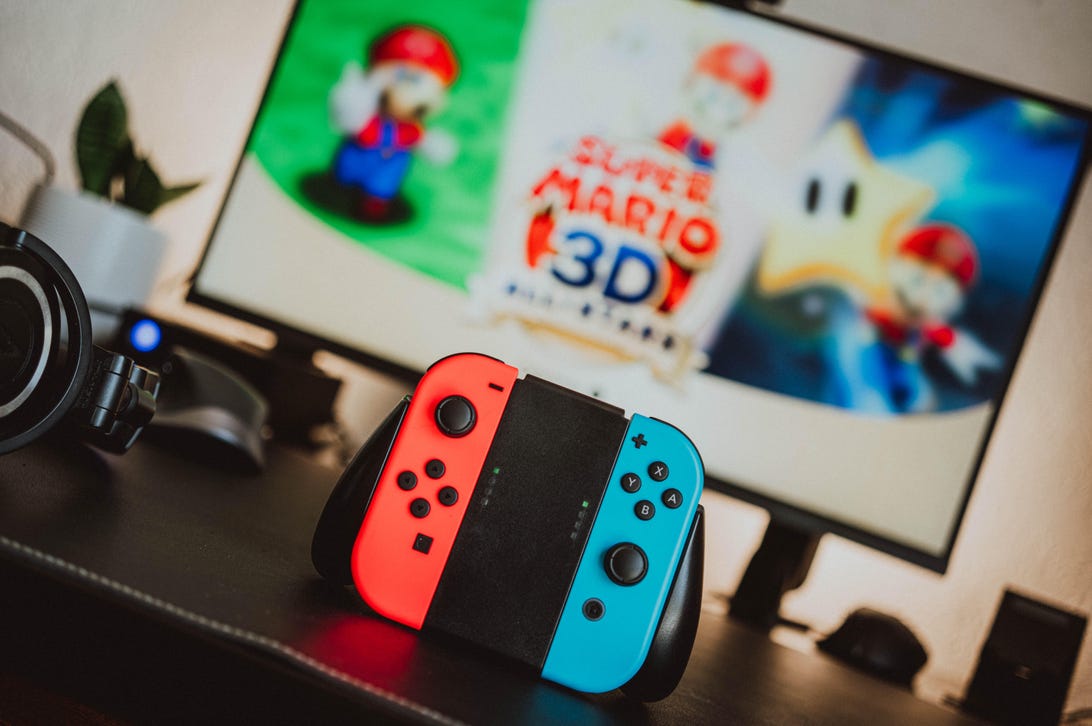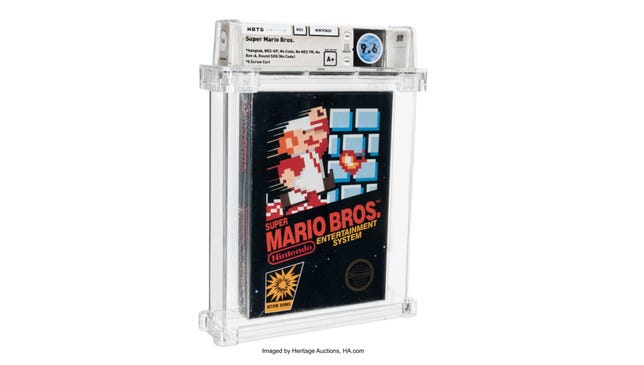
Super Mario 3D All Stars is no longer available for sale on the Nintendo eShop.
Óscar Gutiérrez/CNETOn April 2, if all goes to plan, a sealed "hang-tab" copy of the original Super Mario Bros. will shatter world records, becoming the most expensive video game in history.
The current highest bid stands at $372,000.
That is an altogether preposterous amount of money, but when you consider the insanity of nonfungible tokens, maybe that prospective bidder will end up with a bargain.
Nonfungible tokens, or NFTs for short, have taken over the internet. They're essentially certificates of authenticity for a digital products -- a piece of digital art, a tweet, a gif...
An audio clip of someone farting.
NFTs represent the digital difference between "owning" and merely consuming art (or tweets, or memes). An easy metaphor: it's like the difference between owning the "real" Mona Lisa and a print of the Mona Lisa.
At least, that's what I tell myself when convincing anyone NFTs make a single lick of sense. Because they absolutely don't.

This baby will set you back $370k.
Heritage AuctionsLook, I get it. NFTs make sense because we say they do. NFTs are sold therefore they exist.
In the same way cryptocurrency (or "real" money for that matter) makes sense because we collectively ascribe value to it, NFTs are valuable because they just… are? Someone can buy an NFT of a Homer Simpson Pepe the Frog for $38,000 and sell it for $320,000. Jack Dorsey can sell an NFT of his tweet for $2.9 million. Good for them, congratulations.
But that doesn't mean any of it actually. makes. sense.
Which brings me back to Mario.
On Friday an original, sealed "hang-tab" (that is, with the tag that lets it hang off a store shelf still attached) copy of the original Super Mario Bros. will sell for at least $372,000. But on Thursday Nintendo stopped the sale of another, seven-month-old Mario game: Super Mario 3D All-Stars.
Starting from Thursday, you can no longer purchase Super Mario 3D All-Stars on the Nintendo Switch eShop. Not only that, but Nintendo will no longer ship physical copies of the game to stores. When the last copy available in stores sells out, that's it. No more Super Mario 3D All-Stars.
Nintendo can argue we were warned in advance. When Super Mario 3D All-Stars was released in September 2020, Nintendo clearly communicated the game could only be bought within a specific timeframe that would end March 31. According to Nintendo, the short window of availability is due to the collection's specific purpose: to celebrate the 35th anniversary of the Mario franchise.
"There are various ways that we're celebrating Mario's 35th," said Doug Bowser, President of Nintendo of America, in an interview with Polygon. "And with some of these titles, we felt it was an opportunity to release them for a limited period of time."
In other words, the collection of games is a polished piece of marketing.
There's demand for Super Mario All-Stars. People still want to buy it, and are still willing to pay full price for it. This isn't a licensing thing. It's a Nintendo thing. The only reason the game is no longer available is because Nintendo thought it could sell more copies, create more buzz and ultimately make more money if the collection was only available for six months.
The whole thing sucks. It sucks because there are people out there who want to play easily accessible versions of classics like Super Mario 64 and Super Mario Galaxy but now can't. It sucks because it worked: Sales of Super Mario 3D All-Stars jumped by 276% week-on-week in the UK.
But it sucks, mainly, because of how calculated it feels. This was an attempt by Nintendo to create an artificial sense of scarcity in a product it can start selling again literally whenever it likes.
Yes, we knew this was coming. But it still sucks -- so much so fans made a meme of it. RIP Mario.
Super Mario 3D All-Stars and NFTs feel as though they occupy similar points on the same spectrum. Both are driven by artificial scarcity: one imaginary, reinforced by humans hungry for status and a quick buck, the other created and enforced by a company trying to drive sales in a way that feels disingenuous.

Super Mario Galaxy: possibly the best 3D Mario ever.
NintendoBoth feel dishonest because it's transparent: brute forcing value upon something for the sake of value minus the history that makes something feel truly valuable.
Which takes me back to Mario. The original Super Mario.
When that sealed "hang-tab" copy of the original Super Mario Bros sells for $372,000 or more, it will almost certainly make headlines for much the same reasons Jack Dorsey selling his tweet for $2.9 million did. Because it's ludicrous. Because it's a huge sum of money that most of us can't comprehend.
But the difference will still feel tangible. Literally. Not just because the owner is purchasing something they can hold with their own two hands, but because there's something more sincere in its direct connection to history.
Scarcity hasn't been forced onto this copy of Super Mario, like it has on NFTs or even Super Mario 3D All-Stars. That scarcity has been earned, through the ravages of time and historical significance.
That scarcity is real. There's nothing cynical about it.
Nintendo can't go back in time, and make more physical copies of Super Mario Bros. But it could, as of right now, push that button and start selling Super Mario 3D All-Stars again. And maybe it should.
"all" - Google News
April 01, 2021 at 11:47AM
https://ift.tt/39yI7CZ
Super Mario All-Stars, NFTs and why artificial scarcity sucks - CNET
"all" - Google News
https://ift.tt/2vcMBhz
Bagikan Berita Ini














0 Response to "Super Mario All-Stars, NFTs and why artificial scarcity sucks - CNET"
Post a Comment